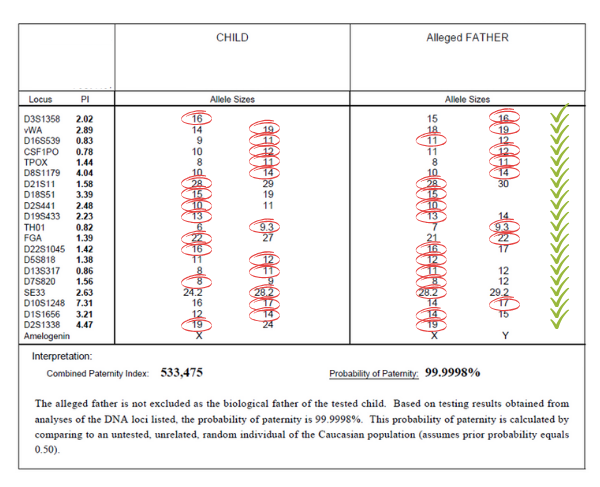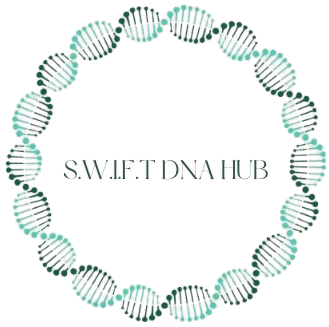DNA Diagnostics Center (DDC) is the world leader in DNA Paternity Testing at home, performing over one million paternity tests each year. Each test is processed at our state-of-the art facility outside Cincinnati, providing online results as soon as 24 to 48 hours after the samples arrive at our lab and go into testing. This detailed paternity test report contains scientific as well as legal terms to describe our highly precise process and your results. Here’s a breakdown of the different sections in the report, and what they mean for you and your family.
DDC Paternity Test Results Report Overview
Your DDC paternity test results report contains the following main sections, with each displaying important information.
- Genetic System Table (Locus/Allele Sizes chart)
- Combined Paternity Index
- Probability of Paternity
- Test Conclusions
Paternity Test Results: Genetic System Table
DDC’s laboratory tests at least 20 different locations on your DNA, as listed in the “locus” column, and compares them with the same locations on the other tested parties. Each child inherits one copy of this DNA segment from the mother, and one copy from the father. These DNA segments are called “alleles”. Our proprietary technology determines the length of each participant’s alleles and compares them with the lengths of the alleged father’s alleles to determine the number of matches. If the mother participates, the mother’s alleles will also be compared. In the example below, the child shown has two sets of alleles at each location tested, and you can see that at least one of these matches with the alleged father’s alleles.

Note: Colored markings are for illustrative purposes only and are not included on actual reports.
Using statistics, the Paternity Index (listed as PI in the table in the upper left) indicates the strength of the match at each Locus (DNA location). In most cases, at least one of the child’s alleles at each location must match one of the father’s at that location. In addition, the DNA location that shows a participant’s sex (male or female), called the Amelogenin locus, is also tested. This is listed at the bottom of the table. One X means female, while one X and one Y means male. Sometimes additional locations on your DNA must be tested to strengthen the results – for example, when two possible fathers are relatives. In this case, those are also listed. When a child has two alleles that are the same size, it will show as just one number on the table. For example, in the first locus in this example, the child received a “16” from both parents.
Paternity Test Results: Combined Paternity Index
The Combined Paternity Index is the number on the lower left side of the report (in the Interpretation section), directly under the Genetic System Table. If you are considered the biological father, there is a number listed for the Combined Paternity Index. If you are not considered the biological father, the report shows “0.” The Combined Paternity Index is an odds ratio indicating how many times more likely it is that the possible father is the biological father than a randomly-selected unrelated man with a similar racial background. In the example shown above, this man is 533,475 times more likely to be the biological father. This number varies on a case by case basis. The higher this number, the stronger the results.
Paternity Test Results: Test Conclusions
The report also shows one of two conclusions: “is not excluded as the biological father” or “is excluded as the biological father.”
- If the conclusion states, “is not excluded as the biological father,” this means the possible father most likely IS the biological father of the child, since all data gathered from the test supports a relationship of paternity.
- If the conclusion states, “is excluded as the biological father,” this means the possible father IS NOT the biological father of the child, since all data gathered from the test do not support a relationship of paternity.


